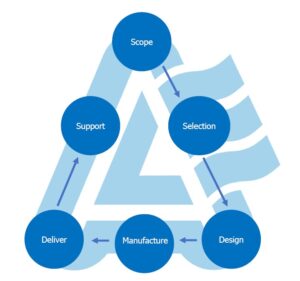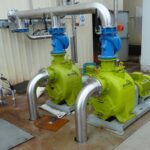Without further delays, let’s dive right into the FAQ section.
1. What is pump efficiency?
Simply put, the term “efficiency” refers to how well a particular machine can convert energy from one form to another. For instance, let’s assume that you supply 10 units of energy to a machine. If the output is 5 units of energy, then we can say that the efficiency of this machine is just 50% or one-half unit.
When it comes to centrifugal pumps, the overall efficiency is the ratio of the output power to the input power. Here’s an equation that illustrates the efficiency of a centrifugal pump:
Ef = Pw / Ps
Here, Ef denotes the efficiency of the pump
Pw Denotes the water power (output)
Ps Denotes the shaft power (input)
2. What is the speed of the pump and how does it affect the Pump Curve?
Specific speed is one of the most important factors in the design of a centrifugal pump. This value came into use in the late 1800s. The specific speed of a pump is independent of the size of the pump. This means you can use existing designs along with test data to design similar pumps with higher or lower flow rates.
Very often, pump users find it a bit overwhelming to use specific speed in pump operations. To simplify it, you can think of it as an index number that helps you predict certain characteristics of the pump. The specific speed value can play a huge role in selecting the right pumps for particular applications and for predicting premature failure.
3. What are the main factors that affect the Operation of a Pump?
Apart from the overall efficiency, several other individual efficiencies affect the functioning of a pump. They are:
- Hydraulic Efficiency – This refers to the shape and spacing of the impeller vanes. Theoretically, an impeller can have an infinite number of vanes, but that isn’t possible due to real-world Generally, centrifugal pumps that handle clear liquids like water have five to seven vanes for every impeller. Pumps that handle solids and slush have lesser number of vanes.
- Volumetric Efficiency – This is determined by the impeller and the volute. It refers to the power lost due to the leakage of the displaced liquid from the wearing rings, the balancing holes or the vane front clearances.
- Mechanical Efficiency – This is another main contributor to the overall efficiency of the pump. Some of the mechanical losses in a centrifugal pump include shaft bearings, leakage from mechanical seals, packing and so on.
Combined efficiency or the overall efficiency of the pump is a combination of all the above-mentioned individual efficiencies.
4. How to Preserve the Efficiency of a Centrifugal Pump?
An important part of the volute is the cut water. This purpose of the cut water (or tongue) is to maintain the flow of the pump into the throat. The optimum clearance between the periphery of the impeller and the tongue is the smallest distance, that doesn’t create pressure pulsations.
A well-designed pump has the right sized impeller that meets these clearance criteria. When an impeller is trimmed down the distance increases, which in turn, allows more fluid to re-circulate back into the throat of the pump.
When the re circulation increases, the efficiency of the pump decreases. So, in order to maintain high-efficiency rates, look to reduce the re-circulation.
5. Does the shape of the Performance Curve predict Efficiency?
Yes. The performance curve and efficiency are highly interlinked. Generally, a typical performance curve is relatively flat at lower specific speeds and becomes more inclined as the specific speed increases.
Pump efficiency is at its lowest at low specific speeds. If the value of your specific speed is less than 500, then you know that your pump is operating at low efficiency. The pump’s efficiency is at its peak when the specific speed values range from 2000 to 3000.
Once again, when the specific speed value goes beyond 3000, the efficiency begins to drop. However, this drop is smaller compared to the drop at low specific speed values.
6. Why does Pump Efficiency Matter?
Simply put, the power consumed by your pump during operation is directly proportional to the output flow and the head it produces. If you need to increase the flow/head, then you have to increase the power supplied to the centrifugal pump.
On the other hand, the power consumed by the pump is inversely proportional to the efficiency of the pump. For the same flow/head output, by increasing efficiency, you can decrease the power requirement.
As you can see, efficiency plays a crucial role in not only the day-to-day operation of the pump but also ensures that the pump lasts for long.
Wrapping it up…
Determining the efficiency of a pump can play a vital role in the overall life and working of your pump. By ensuring that your pump operates at best efficiency, you not only extend the life of your pump but also reduce the operational and maintenance costs, associated with your centrifugal pumps.
If you need further help figuring out the efficiency of your existing industrial centrifugal pumps, or need help choosing the right industrial pumps that operate at maximum efficiency, don’t hesitate to get in touch with our pump experts, here at Allflo, one of the leading manufacturers and suppliers of quality industrial pumps and parts throughout Australia.


























































































